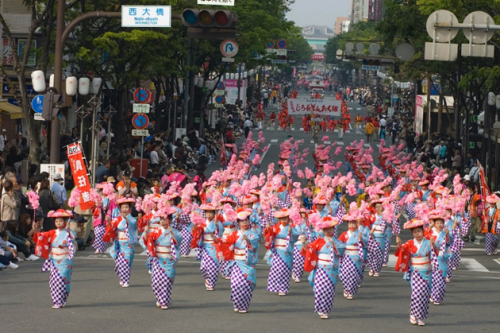 Origins of Dontaku
Origins of Dontaku
History
The name of the festival comes from the Dutch word Zontag – meaning Sunday. However, the origins of the festival are much earlier. Dating back to 1179, the festival was known as Torimon and was a celebration of the Chinese New Year. At the beginning of the Meiji period (Japan’s opening up to the world after the isolation of the Edo period) the festival was banned due to its perceived extravagance. It was soon revived by the citizens of Fukuoka with a new name – the Dontaku Festival.
The origins of Hakata Dontaku can be traced back 840 years to the establishment of the Matsubayashi Parade. This has since developed into a fun celebration that is organized by Hakata locals. The event later became known as the Fukuoka Shimin Matsuri (Citizen’s Festival) since 1962.
Matsubayashi and Dontaku were suspended for eight years during the Second World War. However, the events resumed in 1946 soon after the end of the war to help rejuvenate Fukuoka. It is said that the sound of people marching through the rubble helped restore confidence among the locals. The following year, the Fukuoka Chamber of Commerce and Industry helped organize the first full-scale post-war Dontaku Festival.
 A True Citizen’s Festival
A True Citizen’s Festival
On May 3 and 4 this area buzzes with activity when about 650 groups of marching and performers, totalling more than 33,000 people, participate in Dontaku. Daytime performances across 39 stages follow, and in the evening, illuminated “Flower Cars” (decorated vehicles) parade through the streets.
Groups and individuals from all over Kyushu descend on Fukuoka to join these parades: local citizens’ associations, schools, private companies, small businesses, marching bands, and drum majorettes – all dancing freely in the street while showcasing their unique costumes and talents. Several international groups will share their own cultures whilst marching in the parades. This inclusion of overseas visitors fits very well with Dontaku’s current theme – celebrating Japan’s diversity – and is an occasion for people from all walks of life to meet and wish each other well.
While the highlight of the festival may be the two parades, Dontaku includes a variety of other entertainment, including floats, nighttime illuminations, food stalls and stage shows. Around 30 stages are erected throughout the city, an opportunity for thousands of people to take turns performing traditional dances, folk songs, and contemporary music. Closing the two-day festival are renditions of the Dontaku dance that spectators are invited to participate in. The intriguing mix of ancient traditions and modern exuberance make Dontaku a festival unlike any other in Kyushu – a unique blend of past and present, much like Japan itself!
The festival itself features teams of extravagantly costumed dancers as well as decorated floats called hana jidosha (flower cars). There will be people from in and outside of Fukuoka as well as from overseas to see this huge festival. This festival has two main parts which are parade and performance. Men and women regardless of age walk through the streets in various costumes, and they are playing some instruments, and others clap with rice scoping spoons (Shamoji).
Over the two days of dances and processions, an estimated 2 million people cheer on the participants. We attended both days and still didn’t take in all that was on offer. It’s truly a citizen’s festival.
https://www.fukuoka-now.com/en/hakata-dontaku/https://youtu.be/PS6WGIaJ3eo




















